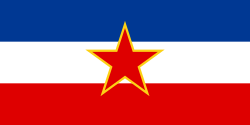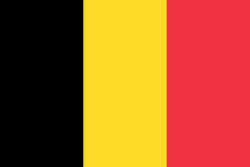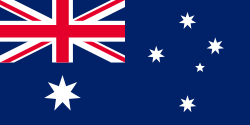Karate-Weltmeisterschaft 1986
Die achten Karate-Weltmeisterschaften fanden 1986 in Sydney, Australien statt.
Medaillen
Männer
| Disziplin | Gold | Silber | Bronze |
|---|---|---|---|
| Kata Herren | Tsuguo Sakamoto | Tomoyuki Aihara | Dario Marchini |
| Kata Team | |||
| Kumite bis 60 kg | Hideto Nakano | Y. Uchi | Steve McKinnon |
| Rudolphe Vallée | |||
| Kumite bis 65 kg | Eizu Kondo | Yuichi Suzuki | Erik Pilspa |
| Marc van Reybrouck | |||
| Kumite bis 70 kg | Thierry Masci | Kyo Hayashi | Manuel Monzon |
| Maurice Negro | |||
| Kumite bis 75 kg | Kenneth Leeuwin | José Carlos de Oleveira | Tom Lilovac |
| Ian Mapier | |||
| Kumite bis 80 kg | Jacques Tapol | Pat McKay | José Manuel Egea |
| Gianluca Guazzaroni | |||
| Kumite über 80 kg | Vic Charles | Geoff Thompson | Waldemar Rauch |
| Frank Bura | |||
| Kumite offen | Karl Daggfeldt | Claudio Guazzaroni | Dudley Josepa |
| José Manuel Egea | |||
| Team | |||
Damen
| Event | Gold | Silber | Bronze |
|---|---|---|---|
| Kata Damen | Mie Nakayama | Miki Hashimoto | Claire Curtis |
| Kata Team | |||
| Kumite bis 53 kg | Sari Kauria | Yumi Yanagisawa | Yuko Hasama |
| Sari Laine | |||
| Kumite bis 60 kg | Ritva Varelius | Molly Samuel | Solveig Hansen |
| Christine Ferguson | |||
| Kumite über 60 kg | Guus van Mourik | Kari Lunde | Keiko Kawano |
| Yvette Bryan |
Medaillenspiegel
| Rang | Land | Gold | Silber | Bronze | Gesamt |
|---|---|---|---|---|---|
| 1 | 5 | 7 | 2 | 14 | |
| 2 | 2 | 3 | 2 | 7 | |
| 3 | 2 | 2 | 1 | 5 | |
| 4 | 2 | 0 | 2 | 4 | |
| 5 | 2 | 0 | 1 | 3 | |
| 6 | 1 | 0 | 1 | 2 | |
| 7 | 1 | 0 | 0 | 1 | |
| 8 | 0 | 1 | 3 | 4 | |
| 9 | 0 | 1 | 1 | 2 | |
| 10 | 0 | 1 | 0 | 1 | |
| 11 | 0 | 0 | 4 | 4 | |
| 12 | 0 | 0 | 2 | 2 | |
| 13 | 0 | 0 | 1 | 1 | |
| 13 | 0 | 0 | 1 | 1 | |
| 13 | 0 | 0 | 1 | 1 | |
| 13 | 0 | 0 | 1 | 1 | |
| 13 | 0 | 0 | 1 | 1 | |
| 13 | 0 | 0 | 1 | 1 | |
| 13 | 0 | 0 | 1 | 1 | |
| Total | 15 | 15 | 26 | 56 | |
Weblinks
Auf dieser Seite verwendete Medien
Variant version of a flag of Japan, used between January 27, 1870 and August 13, 1999 (aspect ratio 7:10).
Variant version of a flag of Japan, used between January 27, 1870 and August 13, 1999 (aspect ratio 7:10).
Flag of the Socialist Federal Republic of Yugoslavia (1946-1992).
The design (blazon) is defined in Article 4 of the Constitution for the Republic of Yugoslavia (1946). [1]
Flagge des Vereinigten Königreichs in der Proportion 3:5, ausschließlich an Land verwendet. Auf See beträgt das richtige Verhältnis 1:2.
Flagge des Vereinigten Königreichs in der Proportion 3:5, ausschließlich an Land verwendet. Auf See beträgt das richtige Verhältnis 1:2.
Flag of Canada introduced in 1965, using Pantone colors. This design replaced the Canadian Red Ensign design.
Die quadratische Nationalfahne der Schweiz, in transparentem rechteckigem (2:3) Feld.
The flag of Brazil from 1968 to 1992 with 23 stars.
The flag of Brazil from 1968 to 1992 with 23 stars.
Flag of Australia, when congruence with this colour chart is required (i.e. when a "less bright" version is needed).
See Flag of Australia.svg for main file information.Chinese Taipei Olympic Flag. According to the official website of Chinese Taipei Olympic Committee, Blue Sky(circle) & White Sun(triangles) above the Olympic rings is neither the National Emblem of the Republic of China, nor the Party Emblem of Kuomintang (KMT), but a design in between, where the triangles do not extend to the edge of the blue circle, as registered at International Olympic Committee in 1981 and digitally rendered in 2013. Besides, the blue outline of the five-petaled plum blossom is broader than the red one. Moreover, the CMYK code of the blue one and the Blue Sky & White Sun is "C100-M100-Y0-K0", and different from the Olympic rings (C100-M25-Y0-K0). Note that it's the only version recognized by IOC.
















